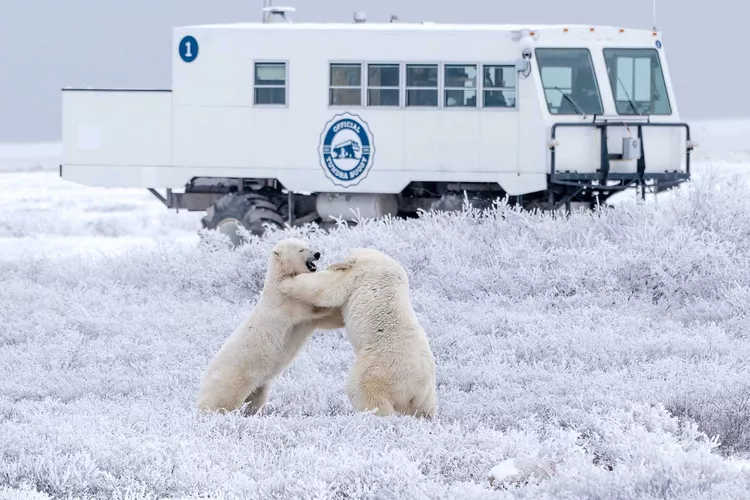Summary
Churchill: The Polar Bear Capital of the World
In a small Canadian town just south of the Arctic Circle, bear sightings are becoming increasingly common. One travel writer takes a tundra safari to find out why.
It’s one thing to look at a 1,200-pound polar bear from across the snowy tundra. It’s another to get close enough to see the snowflakes on its nose. In Churchill, Manitoba, both kinds of encounters are part of everyday life.
Polar Bears in Churchill
Churchill, located on the western side of Canada’s Hudson Bay, is one of the few places in the world with a human population that routinely interacts with polar bears. The town has about 1,050 year-round inhabitants and roughly 1,200 polar bears that arrive during peak season in late summer. Signs around the area proudly proclaim it the “polar bear capital of the world.”
Bears that wander into town are sometimes safely guided to “polar bear jail” — a former military aircraft hangar where they receive medical attention, and then tagged and relocated far from town.
Although bear-inflicted injuries are rare, they do happen. However, there hasn’t been a fatal attack since the 1980s, thanks in part to neighborhood-watch efforts and a new radar system known as “bear-dar” that warns residents when an animal is approaching. Consequently, locals typically leave their car doors unlocked, just in case anyone needs to shelter quickly.
Tundra Safari Experience
As early as August, the bears — which use sea ice for both transportation and hunting seals — begin to seek refuge on land as the ice recedes. They return to congregate in October when the ice comes back, waiting for their frozen rides out of town. This leads approximately 10,000 travelers to Churchill each fall, usually arriving on a two-hour flight from Winnipeg since there are no roads leading into town.
:max_bytes(150000):strip_icc():format(webp)/TAL-polar-bear-geoff-york-POLARBEARS0223-ef40bfa4434e4aef89496c61eef94a35.jpg)
During my visit to Churchill in November, typically just after the viewing season, I was told there was a chance I wouldn’t see any bears. Nevertheless, my adrenaline surged as I stepped outside the Aurora Inn, scanning for any wayward bears. I met with fellow travelers on a five-day trip organized by Frontiers North Adventures, a family-owned outfitter operating in the area since 1987. While the bears are the primary attraction, visitors can also experience beluga whales or the northern lights depending on the season.
We drove out of town to meet Frontier North’s Tundra Buggy, a specialized vehicle that seats 40 and measures 13 feet from wheels to roof. Scanning the landscape, our group attempted to determine if the large white shapes we spotted in the distance were mounds of snow or polar bears. Once we identified bears, the buggy halted, allowing guests to venture out to the back deck, suspended five feet off the ground. We didn’t have to wait long before spotting nearly 40 bears during our five-day trip. The bears put on spectacular displays, from wrestling on the ice to striking amusing poses in the snow.
Impact of Climate Change
However, the stark reality was that these bears weren’t supposed to be there, as their typical season had ended, yet they had nowhere else to go. I consulted with Geoff York from Polar Bears International, who discussed the significant impact climate change has had on polar bear populations. A comparison of satellite maps showed a stark decrease in ice coverage from November 2015 to 2021. The implications are serious; without sea ice to travel on, the bears are left stranded on land, severed from their food source.
Dr. Thea Bechshoft, a marine mammal biologist at PBI, highlighted that while polar bears are strong swimmers, they are not fast enough to catch seals if they are in open water. They rely on sea ice as a crucial platform for hunting.
:max_bytes(150000):strip_icc():format(webp)/TAL-polar-bear-holding-facility-mural-POLARBEARS0223-88b2455addc94489b1fcf082b15158af.jpg)
On average, polar bears now spend an additional day on land each year, leading to weight loss among these majestic creatures. Particularly concerning are the females, who need to weigh more than 420 pounds to reproduce. Reports indicate a decline in cub births and overall survival of the population, with approximately 30 percent of the bears in Western Hudson Bay lost since the 1980s. Significantly, those bears spotted outside our buggy hadn’t eaten in more than 140 days, edging towards starvation.
Explore Churchill
Researchers at PBI are committed to raising awareness and providing education about these magnificent animals. Their efforts include live cameras, educational displays, and resources highlighting the importance of protecting bear habitats.
Having seen a polar bear in the wild, it’s challenging to envision a world without them. They serve as indicators of climate change effects. To ensure their survival — and our own — we must protect the sea ice, which plays a vital role in regulating the earth’s climate. “We call it the earth’s air conditioner,” explained Dr. Bechshoft, indicating the essential need to preserve this ice for both polar bears and the broader ecosystem.
During my downtime in Churchill, I wandered the town, marveling at the multiple murals painted by international artists and visiting the Itsanitaq Museum, which hosts a variety of Inuit carvings and artifacts dating back to 1700 B.C. Over meals at the Tundra Pub, I interacted with locals, sharing stories about bear encounters and the fascination of spotting a mother and her cub.
Ultimately, my sightings were all from inside the buggy since the polar bears roamed nearby but remained elusive during evening strolls. Each time a bear was sighted, anticipation filled the air as we quietly lowered our windows, poised to capture the moment with our cameras.




